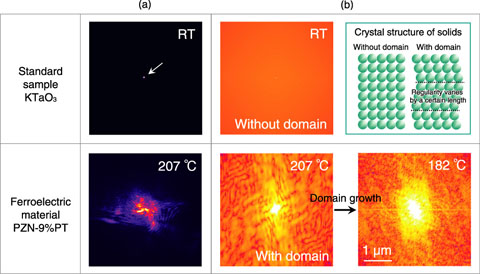
This Picture(219KB)
Fig.4-12 Domain configurations observed by using coherent X-rays
A crystal is a solid material whose 1023 constituent atoms are arranged in an orderly repetitive pattern extending in all three spatial dimensions. In some cases, the arrangement rules change with a certain length, which leads to the spontaneous formation of domains (Fig.4-12 inset). Domains are well known to enhance the physical properties of solids. Therefore, the investigation of the precise nature of these domains is crucial for application in industry and fundamental physics.
High functionality is generally seen in relaxors, giant magnetoresistive effects, shape memory effect, etc. We believe that these effects should be based on a common rule. Thus, the domain formation process and the relationship between the domains and the high functionality should be clarified for industrial application and fundamental physics.
A new X-ray diffraction method based on the use of coherent X-rays can be employed to promote the research trend. Such coherency is suitable for observing the incoherency in the crystals, i.e., domains.
We developed a new coherent X-ray diffraction (CXD) apparatus at BL22XU of SPring-8 for observing nanometer-to-micrometer-scale domains. We achieved a multiple-length-scale approach from macroscale (10 μm) to nanoscale (0.4 nm), which cannot be observed by a conventional X-ray diffraction method. Thus, the relationship between the physical properties and the multiple-length-scales in solids can be investigated.
Fig.4-12(a) shows the CXD patterns of the standard sample KTaO3 (upper panel) and the ferroelectric material 91% Pb(Zn1/3Nb2/3)O3-9% PbTiO3 (PZN-9%PT: lower panel). The CXD pattern of PZN-9%PT is much more complex than that of KTaO3 because of the domain structure in the former. The Fourier transformation in Fig.4-12 (a) shows a homogeneous image for KTaO3 and an inhomogeneous image for PZN-9%PT, reflecting a domain with a size of hundreds of nanometers. The domain structure evolves to about 1 μm as the temperature decreases. The existence of the 1 μm domain is revealed to enhance the dielectric permittivity in Hz-kHz alternating electric field by a factor of 2.
This research was supported by a Japan Science and Technology Agency grant (CREST: Core Research for Evolutional Science and Technology).